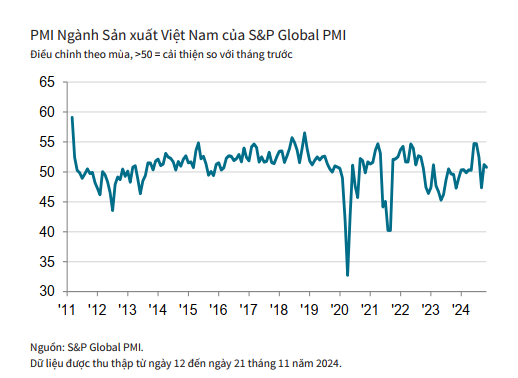 |
Similar to overall business conditions, output in the manufacturing sector rose for the second month running in November. However, the rate of expansion softened from October.
Some companies raised production to meet higher new orders, but others reported weak demand, leading to a slower increase in output. Although total new orders rose amid improved demand and new clients, weak international demand weighed on the overall growth.
In fact, new orders from abroad fell for the second time in three months, with export sales decreasing at the sharpest rate since July 2023.
While output and new orders continued to rise, albeit at softer rates, employment fell for the second month in a row in November. In some cases, companies reduced their workforce to help cut costs.
With a lower headcount, companies continued to struggle to complete orders on time. Consequently, backlogs of work rose for the sixth month in a row, although the rate of increase was the slowest since June.
Firms’ efforts to control costs led to a slightly softer increase in input prices during November, which was weaker than the average for 2024 so far. Where input costs rose, this was linked to scarce supply and a weak currency.
Similarly, output charges rose only marginally in November, with the rate of inflation little-changed from October.
Manufacturers again faced lengthening delivery times from their suppliers in the middle part of the final quarter of the year. Delivery times lengthened for the third month running, and to a greater extent than in October. Suppliers experienced transportation issues and difficulties in sourcing raw materials.
Meanwhile, companies reduced their purchasing activity for the second time in three months, following a slight increase in October. The decrease in purchases of input goods and problems with the delivery of materials led to a renewed fall in stocks of purchases, with the rate of decline being substantial. Stocks of finished goods also decreased as warehouse items were used to meet order demands. The rate of reduction was the sharpest since July.
Business confidence eased for the second month running in November, with the rate of decline the quickest since January. However, manufacturers remained optimistic that output would increase over the next year, with expectations linked to plans to launch new products and expand operations, alongside higher new orders.
Andrew Harker, Economics Director at S&P Global Market Intelligence, said: “While Vietnam’s manufacturing sector remained in growth territory during November, there was a slight disappointment as rates of expansion in output and new orders softened rather than picked up further momentum following the disruption caused by Typhoon Yagi in September. To some degree, the slowdown reflected weak international demand, as exports fell at the sharpest rate since July 2023.
Companies continued to focus on controlling costs, and this contributed to lower employment, which in turn restricted firms’ ability to complete orders on time. Hopefully, stronger demand in coming months will enable companies to feel more confident about boosting capacity.”
Unveiling a Coastal Paradise: Transforming a 1,000-Year-Old Historic Land into a “Golden Treasure”.
This land was once a desolate marshland, a wild and untamed place. Today, it has been transformed into a lush and bountiful landscape, a testament to the power of nature and the potential that lies within.
“Overseas Employment: Nurturing a High-Skilled Workforce”
Sending workers overseas is a strategic move to cultivate a high-quality workforce. When these workers return to the domestic labor market, they bring with them a wealth of knowledge, a strong work ethic, and a unique cultural perspective. This exchange program creates a ripple effect, infusing Vietnam’s labor market with a talented and globally-minded workforce, fostering a culture of industry and innovation, and building a bridge between Vietnam and the international community.
Hiring Spree: Businesses Boost Recruitment in the Final Quarter
To meet the demands of the upcoming peak business season, many enterprises are currently on a hiring spree, actively recruiting a large number of workers, particularly in the service and industrial sectors.
The Future of Work: Navigating the Labor Market in the Fourth Industrial Revolution
The Fourth Industrial Revolution has ushered in a plethora of new industries and, with it, a surge in demand for highly skilled workers to facilitate this transition. Today’s society no longer solely values academic qualifications but places a premium on vocational skills and competencies that meet the needs of these emerging industries.





















